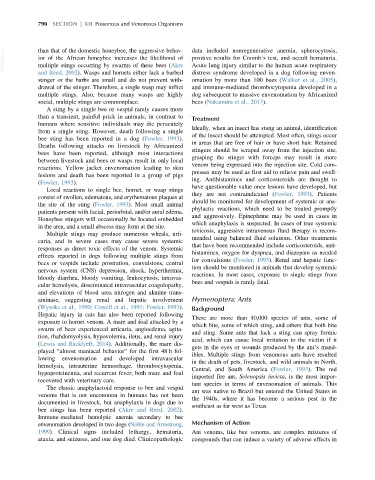Page 832 - Veterinary Toxicology, Basic and Clinical Principles, 3rd Edition
P. 832
790 SECTION | XII Poisonous and Venomous Organisms
VetBooks.ir than that of the domestic honeybee, the aggressive behav- data included nonregenerative anemia, spherocytosis,
positive results for Coomb’s test, and occult hematuria.
ior of the African honeybee increases the likelihood of
Acute lung injury similar to the human acute respiratory
multiple stings occurring by swarms of these bees (Akre
and Reed, 2002). Wasps and hornets either lack a barbed distress syndrome developed in a dog following enven-
stinger or the barbs are small and do not prevent with- omation by more than 100 bees (Walker et al., 2005),
drawal of the stinger. Therefore, a single wasp may inflict and immune-mediated thrombocytopenia developed in a
multiple stings. Also, because many wasps are highly dog subsequent to massive envenomation by Africanized
social, multiple stings are commonplace. bees (Nakamura et al., 2013).
A sting by a single bee or vespid rarely causes more
than a transient, painful prickinanimals,incontrast to
Treatment
humans where sensitive individuals may die peracutely
Ideally, when an insect has stung an animal, identification
from a single sting. However, death following a single
of the insect should be attempted. Most often, stings occur
beestinghas been reportedinadog(Fowler, 1993).
in areas that are free of hair or have short hair. Retained
Deaths following attacks on livestock by Africanized
stingers should be scraped away from the injection site;
bees have been reported, although most interactions
grasping the stinger with forceps may result in more
between livestock and bees or wasps result in only local
venom being expressed into the injection site. Cold com-
reactions. Yellow jacket envenomation leading to skin
presses may be used as first aid to relieve pain and swell-
lesions and death has been reported in a group of pigs
ing. Antihistamines and corticosteroids are thought to
(Fowler, 1993).
have questionable value once lesions have developed, but
Local reactions to single bee, hornet, or wasp stings
they are not contraindicated (Fowler, 1993). Patients
consist of swollen, edematous, and erythematous plaques at
should be monitored for development of systemic or ana-
the site of the sting (Fowler, 1993). Most small animal
phylactic reactions, which need to be treated promptly
patients present with facial, periorbital, and/or aural edema.
and aggressively. Epinephrine may be used in cases in
Honeybee stingers will occasionally be located embedded
which anaphylaxis is suspected. In cases of true systemic
in the area, and a small abscess may form at the site.
toxicosis, aggressive intravenous fluid therapy is recom-
Multiple stings may produce numerous wheals, urti-
mended using balanced fluid solutions. Other treatments
caria, and in severe cases may cause severe systemic
that have been recommended include corticosteroids, anti-
responses as direct toxic effects of the venom. Systemic
histamines, oxygen for dyspnea, and diazepam as needed
effects reported in dogs following multiple stings from
for convulsions (Fowler, 1993). Renal and hepatic func-
bees or vespids include prostration, convulsions, central
tion should be monitored in animals that develop systemic
nervous system (CNS) depression, shock, hyperthermia,
reactions. In most cases, exposure to single stings from
bloody diarrhea, bloody vomiting, leukocytosis, intravas-
bees and vespids is rarely fatal.
cular hemolysis, disseminated intravascular coagulopathy,
and elevations of blood urea nitrogen and alanine trans-
aminase, suggesting renal and hepatic involvement Hymenoptera: Ants
(Wysoke et al., 1990; Cowell et al., 1991; Fowler, 1993). Background
Hepatic injury in cats has also been reported following
There are more than 10,000 species of ants, some of
exposure to hornet venom. A mare and foal attacked by a
which bite, some of which sting, and others that both bite
swarm of bees experienced urticaria, angioedema, agita-
and sting. Some ants that lack a sting can spray formic
tion, rhabdomyolysis, hypovolemia, ileus, and renal injury
acid, which can cause local irritation to the victim if it
(Lewis and Racklyeft, 2014). Additionally, the mare dis-
gets in the eyes or wounds produced by the ant’s mand-
played “almost maniacal behavior” for the first 48 h fol-
ibles. Multiple stings from venomous ants have resulted
lowing envenomation and developed intravascular
in the death of pets, livestock, and wild animals in North,
hemolysis, intrauterine hemorrhage, thrombocytopenia,
Central, and South America (Fowler, 1993). The red
hypoproteinemia, and recurrent fever; both mare and foal
imported fire ant, Solenopsis invicta, is the most impor-
recovered with veterinary care.
tant species in terms of envenomation of animals. This
The classic anaphylactoid response to bee and vespid
ant was native to Brazil but entered the United States in
venoms that is not uncommon in humans has not been
the 1940s, where it has become a serious pest in the
documented in livestock, but anaphylaxis in dogs due to
southeast as far west as Texas.
bee stings has been reported (Akre and Reed, 2002).
Immune-mediated hemolytic anemia secondary to bee
envenomation developed in two dogs (Noble and Armstrong, Mechanism of Action
1999). Clinical signs included lethargy, hematuria, Ant venoms, like bee venoms, are complex mixtures of
ataxia, and seizures, and one dog died. Clinicopathologic compounds that can induce a variety of adverse effects in

